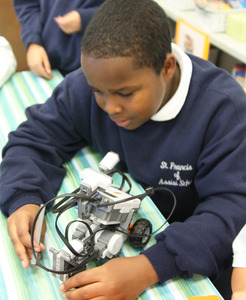STEM on a Shoestring: A Parent’s Perspective
By Sandra Young, Ph.D.
05-02-2014
Lessons learned from starting an after-school STEM club at a small Catholic school
This is the first in a multi-part series about how St. Francis of Assisi School, a small K-8 neighborhood Catholic school in Baltimore City, started an after-school STEM Club on a shoestring budget.
 In the 2012-13 school year, St. Francis of Assisi School started an after-school STEM Club to get kids excited about STEM fields – science, technology, engineering and math. As a professional scientist and an active parent volunteer, I worked with our principal, Rebecca Malone, and two lead teachers to start the club. Together we conquered everything from recruiting students, to planning activities, to raising money, and engaging more parent volunteers.
In the 2012-13 school year, St. Francis of Assisi School started an after-school STEM Club to get kids excited about STEM fields – science, technology, engineering and math. As a professional scientist and an active parent volunteer, I worked with our principal, Rebecca Malone, and two lead teachers to start the club. Together we conquered everything from recruiting students, to planning activities, to raising money, and engaging more parent volunteers.
Why STEM?
STEM subjects foster critical thinking skills, which are used throughout life no matter what career path a student takes. Moreover, new science standards focus on project-based learning where the intent is for students to utilize basic book knowledge but demonstrate more creativity in applying what they know. It has been shown that non-formulary learning like this is important for students to develop problem-solving skills.
Who Signed Up?
Much to our delight, the STEM Club became a popular after-school activity. Approximately 40 students signed up in our first year – a significant number given that it represents nearly one-fifth of our total school population. Now in its second year, the STEM Club has grown to more than 60 students. Interestingly, I heard from many parents who said their children were excited to sign up because their friends had talked about how much they were learning and how fun the experience was.
What Have We Learned?
In starting our own after-school STEM program, we learned the importance of good planning, student and volunteer engagement, and community involvement. Here are some ideas that have come from our work thus far that might help other interested parents, teachers, and principals start their own STEM Club on a “shoestring” budget.
- Recruit plenty of adult volunteers. In addition to dedicated teachers, you need at least as many parents. A decent adult-to-student ratio helps to ensure that activities run smoothly. Yet it’s important to realize that adults don’t need to have all the answers – it’s OK to say to the kids, “I don’t know but I bet you can figure it out!” Volunteers don’t even need a science background; it’s more important that the individuals leading the club be organized and willing to learn some of the STEM topics alongside the kids. You’re never too old to learn new things!
- Plan the entire year’s activities. Having a general layout of what you’re going to do with the students for the entire school year may sound daunting, but it's easier to make changes to an existing plan along the way than come up with an entirely new plan at the last minute. It is also a good idea to have materials available for back-up activities, in case they are needed.
- Focus on activities not in the traditional curriculum. An after-school program is a good opportunity to focus on things not learned in the traditional curriculum such as robotics, Rube Goldberg machines, snap circuits, computer science unplugged (you don't even need a computer to do CS unplugged), etc. While many of these activities have initial start-up costs, the materials are reusable. And from an educational standpoint, any focus on non-formulary work is good if the students can be kept on task.
- Set goals. Developing short, medium, and long-term goals for our STEM Club helped keep us focused on where we were headed.
- Encourage students to reflect on what they learn. We recently decided to have our students bring a lab notebook at the beginning of the year to write down their thoughts and ideas about the project(s) throughout the year.
- Promote the club’s work. Internally, we promote the Club via a STEM newsletter to parents, so they’re aware of the Club’s activities as well as other ways that STEM is integrated at the school. Our newsletter includes a list of both school and local STEM events. We also offer an annual STEM Night to get the school community in the spirit of “STEM is important and fun.”
- Network with others. You aren't in this alone. Talk to other teachers, parents, and science professionals. You never know where your next idea (or next grant) will come from.
- Approach everything with a good sense of humor. Things do not always go according to plan. Just remember that the students are there to learn and have fun.
Sandra “Sandy” Young is a Materials Engineer by training and currently serves as a Program Manager for the U.S. Army Education Outreach Programs and the Aberdeen Proving Ground STEM Center in Maryland, which provides programs in science, technology, engineering and math for K-12 and college students. She holds a bachelor’s degree in Chemistry and a Ph.D. in Polymer Science and Engineering. She is also a proud parent of a second grade student and an active volunteer at St. Francis of Assisi School. Learn more about Sandy by reading an article or viewing a video of her work as a STEM educator.
